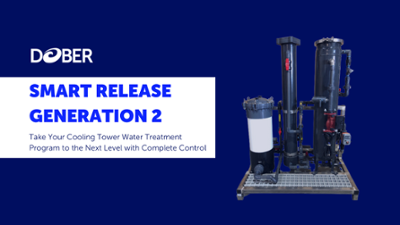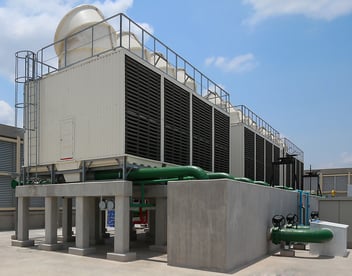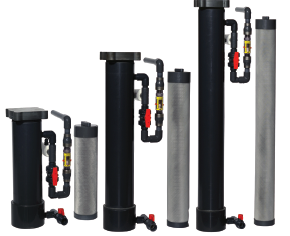Cooling Tower Chemicals: Liquids vs. Solids
Cooling tower water treatment is a delicate process that requires you to select the right cooling tower chemicals for your operation.
Your pH needs to fall within a certain range or you're asking for corrosion or scaling of your cooling tower. You also want to feed cooling tower chemicals into your system to mitigate and prevent corrosion, scale and microbiological fouling. At the same time, you ideally want to feed chemicals only when you need to do so.
You also want your system to be as efficient as possible, mitigating the need for more make-up water into the system.
We could go on and on. We get it: there's a lot going on in any cooling tower water treatment program. Complicating matters further is that every cooling tower is different; as such, it follows that every cooling tower water treatment program is different, too.
But there's another debate to consider: liquids or solids.
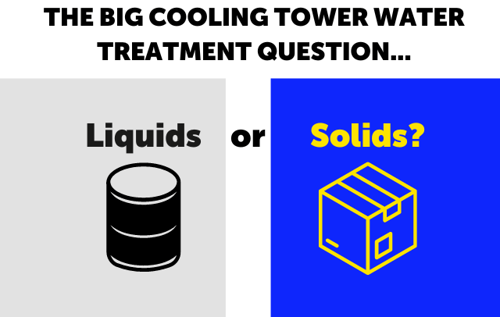
What do we mean by that? First, let's zoom out for a general discussion of cooling tower water treatment chemicals and what they do, why you need them and how they work in the cooling tower system.
- Overview the role of cooling tower water treatment chemicals in the cooling tower system
- Summarize the problems cooling tower water treatment chemicals aim to address
- Touch on some of the differences between solid and liquid cooling tower water treatment programs
If you'd like to learn more about Smart Release Technology and Smart Release Generation 2, which offers the benefits of a liquid program while delivering with solids, download our free e-book below. We'd be happy to chat about how we can help you implement a safer, effective and more environmentally friendly cooling tower water treatment program using solid-based chemistries.
why do you need Cooling Tower Chemicals?
Cooling tower water treatment entails the treating of cooling tower process water in order to mitigate and prevent a number of things, including corrosion, scale and microbiological fouling.
All of these things can contribute to additional equipment maintenance costs, decreased heat-transfer capacity and, in the case of microbiological fouling, potential illnesses (e.g., Legionnaires' disease).
Let's briefly review some of these cooling tower water treatment foes:
Corrosion
Without proper cooling tower water treatment, contaminants in process water can lead of corrosion of surfaces within the cooling tower.
As noted in our review of key cooling tower water treatment terms, your process water generally should be maintained within a certain pH range. Most operate between 7.0-9.5, but there are some systems that might run slightly more acidic or alkaline.
If your process water becomes too acidic, that can lead to corrosion of various surfaces in the cooling tower system.
Excess dissolved solids in the process water also contribute to oxidation of metal surfaces. In short, as total dissolved solids (TDS) increases, so does the potential for corrosion in the system.
Microbiological fouling, often in the form of bacteria, can also lead to corrosion.
Scale
Scale is one of the most common problems encountered in cooling water systems. Scale, most commonly in the form of calcium carbonate (CaCO³), forms through the precipitation of minerals when the concentration of ions in solutions exceed the mineral solubility.
Formation of scale in the system is yet another factor that can contribute to less effective heat transfer in the tower. As alkalinity increases in the system, the chances of scale formation also increase.
Some common types of scale deposition are:
- Microbial deposits — created by the action or growth of microorganisms
- Process side leaks — organic foulants introduced to the cooling water from the process material
- Suspended material — insoluble material that settles in low flow areas
- Corrosion products — deposits that result from insoluble materials formed by corrosion
- Mineral scale — precipitation of insoluble compounds from ions in the water
Once again, you need chemicals to address both corrosion and scale in your cooling tower water treatment program.
Microbiological fouling
Microbiological fouling can also be harmful to both your system and, potentially, people around it. Without a regimen of biocides, microbiological growth can flourish in the warm, wet environment of the cooling tower.
The most high-profile example of illness stemming from improperly treated cooling tower systems is incidences of Legionnaires' disease (here's just one recent example of a Legionnaires' disease outbreak). Legionnaires' disease is a form of pneumonia that spreads via the legionella bacteria. Legionella bacteria can spread via aerosols from the cooling tower system; when inhaled, that can lead to Legionnaires' disease, which can be — and has been — fatal in some individuals.
So, in this case, the stakes are extremely high. Inadequate protection against microbiological fouling not only leaves your cooling tower system at risk: it also leaves your personnel and anyone else who may be near the cooling tower site in danger.
pH control
Another aspect of cooling tower water treatment that is vital is managing your system's pH levels. Treatment programs often include pH adjusters that keep levels within a certain range. (As noted previously, while many systems often fall between 7.0-9.5, not every system will run at that pH range.)
Foaming
Lastly, foaming of process water leaving the system can also be a problem in that foam is more likely to carry potential microbiological growth and, in turn, lead to illness in those exposed to it in the environment. As such, defoaming and anti-foaming chemicals are also often a part of cooling tower water treatment programs.
Liquids vs. Solids in cooling tower water treatment
We've talked generally about the role of chemicals in cooling tower water treatment: but what about the types of chemicals you can use — more specifically, the forms of chemicals?
Cooling tower water treaters use liquid or solid programs. Simply put, they either use liquid chemicals to treat their system or solid chemicals (in the case of Smart Release Technology, Dober manufactures solid corrosion and scale tablets and cooling tower biocides to deliver chemicals into the system).
Liquid Cooling Tower Water Treatment Chemicals
All-liquid cooling water programs have been prominent in the cooling tower water treatment industry for years, given it has been the norm for professional water treaters and customers alike.
As with any industry, change can be something many managers might not want to consider. "If something is working just fine, for the most part, why change it?" a property manager might say (or, more colloquially, "if it ain't broke, don't fix it").
That is an understandable perspective, as there can be costs associated with changing any process. In general, liquid chemicals do work effectively in the context of cooling tower water treatment.
Furthermore, with a liquid program, cooling tower engineers can have control of their chemical delivery. That means not having to deliver chemicals at all times, but rather only when the system requires additional treatment.
In short, liquids have been around the cooling tower water treatment industry for a long time. Overall, they tend to be effective, albeit not without some drawbacks relative to solid-based programs.
Solid Cooling Tower Water Treatment Chemicals
As noted, there is a solid-based alternative to the aforementioned liquid option.
While solid-based cooling tower water treatment programs are not currently as widespread as liquid programs, they are becoming increasingly popular.
Here's a quick video showcasing how Dober's solid-based chemicals work:
So why would one potentially use a solid-based program over the traditional liquid-based program?
It should be noted that every cooling tower system is different; in some cases, it could be true that a liquid program might fit a user's needs better than a solid-based program could.
Cost Considerations, safety
However, a solid-based program does have very real benefits relative to its liquid counterpart.
While the chemistries in and of themselves can sometimes be more expensive than liquids, there are other cost savings to consider.
For example, solid chemistries (e.g., tablets) are generally safer for employees in terms of handling, both in terms of potential exposure to chemicals and in handling of packaging. According to the National Safety Council, in 2019-2020, the average workers compensation cost for workplace incidents related to burns or strains reached $54,173 and $35,291, respectively. While those numbers represent an average of all such incidents, they are a general indicator of the costs associated with these types of incidents, which can occur when dealing with liquid chemicals, whether from direct exposure to chemicals or from injuries resulting from moving heavy pails and drums.
Bottom line: injuries to personnel are costly, both to your workers and to the health of the business. In addition to workers' compensation costs, there are costs associated with potentially have to train a new person to fill in for the injured employee.
Tablets can be packaged in recyclable cardboard boxes, whereas liquids are stored in heavy, often difficult-to-move pails and drums.
What does that mean? You might not want to think about it, but workplace injuries are something you have to consider. With solids, personnel can move boxes of solids via ergonomically friendly packaging. Furthermore, Smart Release Technology's coated tablet technology means significantly reduced chances of exposure to potentially harmful chemicals.
Environmental Impacts
There is an also environmental impact to consider. In most cases, a solid-based program will have lower CO2 footprints across multiple process categories. A breakdown of such categories can be seen below:
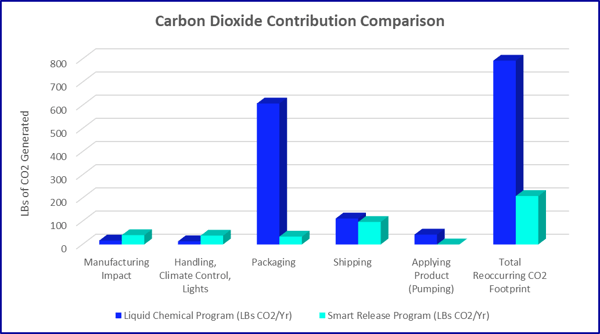
Data source: Mosher, Steve. Environmental Aspects of Controlled-Release Chemistry in Cooling Towers. [White Paper]. Smart Release Technology.
Liquids vs. solids cooling tower chemicals Summary
Liquids or solids: that is the question.
So what's the answer?
The honest answer is ... it depends.
As we always say, every cooling tower system is different. Conditions differ from site to site.
However, there are some issues that remain consistent across sites, particularly the issues of safety and carbon footprint.
With that said, liquids do have some drawbacks relative to solids.
- In terms of cost, liquid chemistries in and of themselves can be cheaper than solids. However, there are cost savings from solids that won't necessarily show up on your balance sheet, like fewer incidences of injury to personnel, less time lost to cleaning liquid spills and leaks, and less cost and headaches related to inventory management (liquids take up more space and require containment, unlike solids).
- Liquids do offer operators control of chemical delivery, which solid-based options don't always do. However, once again, there are solid-based options that are complete control of chemical delivery, just like liquid programs. Smart Release Generation 2, for example, offers a solid-based cooling tower water treatment solution that gives complete control of chemical feed. That means you get the same precision of feed as you would with a liquid program.
- With a solid-based cooling tower water treatment program, you don't have to worry about chemical leaks or spills that can sometimes occur in a liquid program. For example, on the Smart Release Generation 2 feeder system, you will find no chemical metering pumps — only a three-speed recirculation pump.
Ultimately, what type of program can depend on:
- Your site's unique conditions
- Cost considerations
- Safety concerns
- Efficiency/effectiveness of your existing program
- Your organization's stance on change (i.e., is it willing to change from liquid to solid, or is it reluctant to change for any reason)
As always, if you want to learn more about the differences between liquid- and solid-based cooling tower water treatment chemicals, reach out to the Smart Release Technology team to see what type of cooling tower water treatment program would work best for your unique conditions and pain points.


